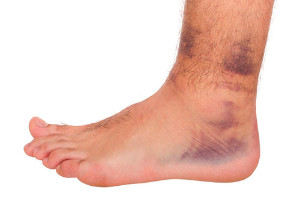Blogs
Is Toenail Fungus Contagious?
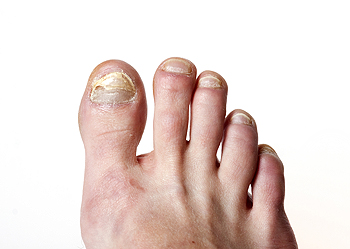 Research has indicated that toenail fungus rarely affects children, but can develop as the aging process occurs. It occurs as a result of the fungus entering the toenail through a small crack in the nail, and will gradually spread when shoes and socks are worn throughout the day. Some of the symptoms that are associated with this ailment can consist of the toenails becoming thick and yellowed, and in severe cases, the nail may lift off of the nail bed. This type of fungus lives and thrives in warm and moist environments, and is often found in public swimming pools, showers room floors, and surrounding areas. It is helpful to wear appropriate shoes while in these types of places, as this may help to reduce the risk of spreading toenail fungus. Toenail fungus is considered to be contagious, and it is beneficial to refrain from sharing towels, socks and shoes. If you are afflicted with this condition, it is suggested that you seek the counsel of a podiatrist who can offer you effective treatment options.
Research has indicated that toenail fungus rarely affects children, but can develop as the aging process occurs. It occurs as a result of the fungus entering the toenail through a small crack in the nail, and will gradually spread when shoes and socks are worn throughout the day. Some of the symptoms that are associated with this ailment can consist of the toenails becoming thick and yellowed, and in severe cases, the nail may lift off of the nail bed. This type of fungus lives and thrives in warm and moist environments, and is often found in public swimming pools, showers room floors, and surrounding areas. It is helpful to wear appropriate shoes while in these types of places, as this may help to reduce the risk of spreading toenail fungus. Toenail fungus is considered to be contagious, and it is beneficial to refrain from sharing towels, socks and shoes. If you are afflicted with this condition, it is suggested that you seek the counsel of a podiatrist who can offer you effective treatment options.
For more information about treatment, contact Dr. Dean D. Hinners of Illinois. Our doctor can provide the care you need to keep you pain-free and on your feet.
Toenail Fungus Treatment
Toenail fungus is a condition that affects many people and can be especially hard to get rid of. Fortunately, there are several methods to go about treating and avoiding it.
Antifungals & Deterrence
Oral antifungal medicine has been shown to be effective in many cases. It is important to consult with a podiatrist to determine the proper regiment for you, or potentially explore other options.
Applying foot powder on the feet and shoes helps keep the feet free of moisture and sweat.
Sandals or open toed shoes – Wearing these will allow air movement and help keep feet dry. They also expose your feet to light, which fungus cannot tolerate. Socks with moisture wicking material also help as well.
If you have any questions please feel free to contact one of our offices located in Metropolis and Eldorado, IL . We offer the newest diagnostic tools and technology to treat your foot and ankle needs.
Is Rheumatoid Arthritis Common?
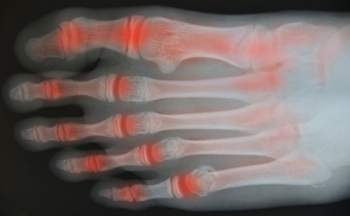 One of the most common types of arthritis is referred to as rheumatoid arthritis. Many people may experience symptoms of this condition in the feet and are aware of the pain and discomfort that typically exists with this ailment. There are specific symptoms that may accompany this type of arthritis, including swelling and soreness in the feet, difficulty waking, which may be a result of unstable joints, or the foot possibly changing shape. Research has shown the part of the foot that may be affected the most are the toes, which consist of smaller joints. They may begin to look deformed and may have difficulty in moving or bending. There may be additional foot conditions that may arise including the development of corns and calluses. This may be a result of changes in the foot shape. If you are afflicted with rheumatoid arthritis, it is suggested to consult with a podiatrist who can offer proper treatment techniques.
One of the most common types of arthritis is referred to as rheumatoid arthritis. Many people may experience symptoms of this condition in the feet and are aware of the pain and discomfort that typically exists with this ailment. There are specific symptoms that may accompany this type of arthritis, including swelling and soreness in the feet, difficulty waking, which may be a result of unstable joints, or the foot possibly changing shape. Research has shown the part of the foot that may be affected the most are the toes, which consist of smaller joints. They may begin to look deformed and may have difficulty in moving or bending. There may be additional foot conditions that may arise including the development of corns and calluses. This may be a result of changes in the foot shape. If you are afflicted with rheumatoid arthritis, it is suggested to consult with a podiatrist who can offer proper treatment techniques.
Because RA affects more than just your joints, including the joints in your feet and ankles, it is important to seek early diagnosis from your podiatrist if you feel like the pain in your feet might be caused by RA. For more information, contact Dr. Dean D. Hinners of Illinois. Our doctor will assist you with all of your podiatric concerns.
What Is Rheumatoid Arthritis?
Rheumatoid Arthritis (RA) is an autoimmune disorder in which the body’s own immune system attacks the membranes surrounding the joints. Inflammation of the lining and eventually the destruction of the joint’s cartilage and bone occur, causing severe pain and immobility.
Rheumatoid Arthritis of the Feet
Although RA usually attacks multiple bones and joints throughout the entire body, almost 90 percent of cases result in pain in the foot or ankle area.
Symptoms
- Swelling and pain in the feet
- Stiffness in the feet
- Pain on the ball or sole of feet
- Joint shift and deformation
Diagnosis
Quick diagnosis of RA in the feet is important so that the podiatrist can treat the area effectively. Your doctor will ask you about your medical history, occupation, and lifestyle to determine the origin of the condition. Rheumatoid Factor tests help to determine if someone is affected by the disease.
If you have any questions please feel free to contact one of our offices located in Metropolis and Eldorado, IL . We offer the newest diagnostic and treatment technologies for all your foot and ankle needs.
What Is a Walking Boot?
A walking boot is an orthotic device used to protect the foot or ankle after an injury. The boot helps keep the foot stable and in the right position so that it can heal properly. Walking boots can also help keep weight and pressure off of an injured area. Injuries that may require wearing a walking boot include broken bones, tendon injuries, severe sprains, and shin splints. Most walking boots have two to five adjustable straps that hold the boot in place over the injured leg. How long you will need to wear the walking boot will depend on your specific injury and its severity. For more information, please consult with a podiatrist.
If you are having discomfort in your feet and would like to try orthotics, contact Dr. Dean D. Hinners from Illinois. Our doctor can provide the care you need to keep you pain-free and on your feet.
What Are Orthotics?
Orthotics are inserts you can place into your shoes to help with a variety of foot problems such as flat feet or foot pain. Orthotics provide relief and comfort for minor foot and heel pain but can’t correct serious biomechanical problems in your feet.
Over-the-Counter Inserts
Orthotics come in a wide variety of over-the-counter inserts that are used to treat foot pain, heel pain, and minor problems. For example, arch supports can be inserted into your shoes to help correct overarched or flat feet, while gel insoles are often used because they provide comfort and relief from foot and heel pain by alleviating pressure.
Prescription Orthotics
If over-the-counter inserts don’t work for you or if you have a more severe foot concern, it is possible to have your podiatrist prescribe custom orthotics. These high-quality inserts are designed to treat problems such as abnormal motion, plantar fasciitis, and severe forms of heel pain. They can even be used to help patients suffering from diabetes by treating foot ulcers and painful calluses and are usually molded to your feet individually, which allows them to provide full support and comfort.
If you are experiencing minor to severe foot or heel pain, it’s recommended to speak with your podiatrist about the possibilities of using orthotics. A podiatrist can determine which type of orthotic is right for you and allow you to take the first steps towards being pain-free.
If you have any questions please contact one of our offices located in Metropolis and Eldorado, IL . We offer the newest diagnostic and treatment technologies for all your foot and ankle needs.
Have I Broken My Toe?
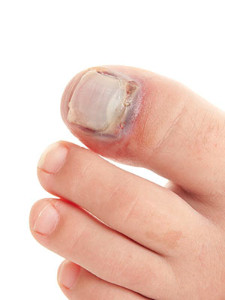 Many patients will experience a broken toe after a heavy object has fallen on it, or if it bangs into a piece of furniture. Consistent movements over an extended period of time can also weaken the bones in the toe, and this may result in a hairline fracture. Some of the symptoms that are associated with a broken toe often include pain, swelling, and bruising. Toes that are severely broken often bleed, and can point in the wrong direction. Many patients find comfort when the toe is elevated, as this may help to control any existing swelling. Additionally, the healing process can begin when the affected toe is taped to the toe next to it, which is referred to as buddy taping. If you feel you have broken your toe, it is suggested that you consult with a podiatrist who can perform an X-ray which confirms this condition, followed by beginning the correct treatment for you.
Many patients will experience a broken toe after a heavy object has fallen on it, or if it bangs into a piece of furniture. Consistent movements over an extended period of time can also weaken the bones in the toe, and this may result in a hairline fracture. Some of the symptoms that are associated with a broken toe often include pain, swelling, and bruising. Toes that are severely broken often bleed, and can point in the wrong direction. Many patients find comfort when the toe is elevated, as this may help to control any existing swelling. Additionally, the healing process can begin when the affected toe is taped to the toe next to it, which is referred to as buddy taping. If you feel you have broken your toe, it is suggested that you consult with a podiatrist who can perform an X-ray which confirms this condition, followed by beginning the correct treatment for you.
A broken toe can be very painful and lead to complications if not properly fixed. If you have any concerns about your feet, contact Dr. Dean D. Hinners from Illinois. Our doctor will treat your foot and ankle needs.
What to Know About a Broken Toe
Although most people try to avoid foot trauma such as banging, stubbing, or dropping heavy objects on their feet, the unfortunate fact is that it is a common occurrence. Given the fact that toes are positioned in front of the feet, they typically sustain the brunt of such trauma. When trauma occurs to a toe, the result can be a painful break (fracture).
Symptoms of a Broken Toe
- Throbbing pain
- Swelling
- Bruising on the skin and toenail
- The inability to move the toe
- Toe appears crooked or disfigured
- Tingling or numbness in the toe
Generally, it is best to stay off of the injured toe with the affected foot elevated.
Severe toe fractures may be treated with a splint, cast, and in some cases, minor surgery. Due to its position and the pressure it endures with daily activity, future complications can occur if the big toe is not properly treated.
If you have any questions please feel free to contact one of our offices located in Metropolis and Eldorado, IL . We offer the newest diagnostic and treatment technologies for all your foot and ankle needs.
Cause and Treatment of Sinus Tarsi Syndrome
If standing or walking for long periods causes a pain on the outside of your ankle, you may have sinus tarsi syndrome. The sinus tarsi is a kind of tunnel between two other foot bones that contains ligaments, muscle, nerves, blood vessels and fat. When it gets pinched, it causes pain in front of and below the pointy bone on the outside of your ankle, which is actually the end of the fibula. Swelling and pain when rotating your foot outward are also symptoms. Sinus tarsi syndrome is common in people who have previously sprained an ankle. Non-operative treatments include stopping the activity that is causing the pain, wearing more comfortable shoes and an ankle brace, taking non-steroidal anti-inflammatory medication, and getting corticosteroid injections. An X-ray or digital imaging test from a podiatrist is suggested for a full examination and diagnosis of your foot and ankle.
Ankle pain can be caused by a number of problems and may be potentially serious. If you have ankle pain, consult with Dr. Dean D. Hinners from Illinois. Our doctor will assess your condition and provide you with quality foot and ankle treatment.
Ankle pain is any condition that causes pain in the ankle. Due to the fact that the ankle consists of tendons, muscles, bones, and ligaments, ankle pain can come from a number of different conditions.
Causes
The most common causes of ankle pain include:
- Types of arthritis (rheumatoid, osteoarthritis, and gout)
- Ankle sprains
- Broken ankles
- Achilles tendinitis
- Achilles tendon rupture
- Stress fractures
- Bursitis
- Tarsal tunnel syndrome
- Plantar fasciitis
Symptoms
Symptoms of ankle injury vary based upon the condition. Pain may include general pain and discomfort, swelling, aching, redness, bruising, burning or stabbing sensations, and/or loss of sensation.
Diagnosis
Due to the wide variety of potential causes of ankle pain, podiatrists will utilize a number of different methods to properly diagnose ankle pain. This can include asking for personal and family medical histories and of any recent injuries. Further diagnosis may include sensation tests, a physical examination, and potentially x-rays or other imaging tests.
Treatment
Just as the range of causes varies widely, so do treatments. Some more common treatments are rest, ice packs, keeping pressure off the foot, orthotics and braces, medication for inflammation and pain, and surgery.
If you have any questions, please feel free to contact one of our offices located in Metropolis and Eldorado, IL . We offer the newest diagnostic and treatment technologies for all your foot care needs.
What Causes Nerve Damage in the Feet?
Peripheral neuropathy, a type of nerve damage that affects the extremities, is a complication associated with several diseases. One of the most common types of neuropathy is diabetic neuropathy. As its name suggests, this type of nerve damage occurs in people who have diabetes. Approximately 25% of diabetics have experienced pain caused by nerve damage. Other potential causes of peripheral neuropathy include vitamin deficiencies, alcohol abuse, foot injuries, hypothyroidism, kidney disease, Charcot-Marie-Tooth disease, and certain infections. Since neuropathy in the feet can cause a reduction or loss of sensation, the feet are at an increased risk of developing wounds, which may become infected. If you have peripheral neuropathy, it is suggested that you be under the care of a podiatrist.
Neuropathy
Neuropathy can be a potentially serious condition, especially if it is left undiagnosed. If you have any concerns that you may be experiencing nerve loss in your feet, consult with Dr. Dean D. Hinners from Illinois. Our doctor will assess your condition and provide you with quality foot and ankle treatment for neuropathy.
What Is Neuropathy?
Neuropathy is a condition that leads to damage to the nerves in the body. Peripheral neuropathy, or neuropathy that affects your peripheral nervous system, usually occurs in the feet. Neuropathy can be triggered by a number of different causes. Such causes include diabetes, infections, cancers, disorders, and toxic substances.
Symptoms of Neuropathy Include:
- Numbness
- Sensation loss
- Prickling and tingling sensations
- Throbbing, freezing, burning pains
- Muscle weakness
Those with diabetes are at serious risk due to being unable to feel an ulcer on their feet. Diabetics usually also suffer from poor blood circulation. This can lead to the wound not healing, infections occurring, and the limb may have to be amputated.
Treatment
To treat neuropathy in the foot, podiatrists will first diagnose the cause of the neuropathy. Figuring out the underlying cause of the neuropathy will allow the podiatrist to prescribe the best treatment, whether it be caused by diabetes, toxic substance exposure, infection, etc. If the nerve has not died, then it’s possible that sensation may be able to return to the foot.
Pain medication may be issued for pain. Electrical nerve stimulation can be used to stimulate nerves. If the neuropathy is caused from pressure on the nerves, then surgery may be necessary.
If you have any questions, please feel free to contact one of our offices located in Metropolis and Eldorado, IL . We offer the newest diagnostic and treatment technologies for all your foot care needs.
What Foods to Avoid if You are Afflicted with Gout
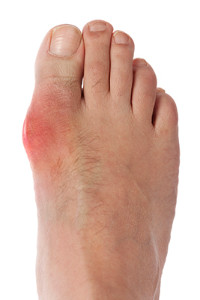 When specific foods are ingested on a frequent basis, a flare-up of a condition known as gout may occur. There are several symptoms that accompany this ailment, including severe pain and discomfort surrounding the big toe, redness, and extreme tenderness when the area is touched. Certain foods have elevated levels of purines, which is known to raise uric acid levels in the blood. This causes crystals to form, and may lodge in the joints of the feet, most commonly the big toe. Research has shown that certain foods should be limited or avoided, which are high in purine levels. These may include alcohol, shellfish, and meat. For patients who experience gout, it may be advised to drink plenty of fresh water frequently, increase the amount of fruits and vegetables that are eaten on a daily basis, and to lose weight slowly if obesity is a factor. Please schedule a consultation with a podiatrist if you are afflicted with gout for immediate treatment options.
When specific foods are ingested on a frequent basis, a flare-up of a condition known as gout may occur. There are several symptoms that accompany this ailment, including severe pain and discomfort surrounding the big toe, redness, and extreme tenderness when the area is touched. Certain foods have elevated levels of purines, which is known to raise uric acid levels in the blood. This causes crystals to form, and may lodge in the joints of the feet, most commonly the big toe. Research has shown that certain foods should be limited or avoided, which are high in purine levels. These may include alcohol, shellfish, and meat. For patients who experience gout, it may be advised to drink plenty of fresh water frequently, increase the amount of fruits and vegetables that are eaten on a daily basis, and to lose weight slowly if obesity is a factor. Please schedule a consultation with a podiatrist if you are afflicted with gout for immediate treatment options.
Gout is a foot condition that requires certain treatment and care. If you are seeking treatment, contact Dr. Dean D. Hinners from Illinois. Our doctor will treat your foot and ankle needs.
What Is Gout?
Gout is a type of arthritis caused by a buildup of uric acid in the bloodstream. It often develops in the foot, especially the big toe area, although it can manifest in other parts of the body as well. Gout can make walking and standing very painful and is especially common in diabetics and the obese.
People typically get gout because of a poor diet. Genetic predisposition is also a factor. The children of parents who have had gout frequently have a chance of developing it themselves.
Gout can easily be identified by redness and inflammation of the big toe and the surrounding areas of the foot. Other symptoms include extreme fatigue, joint pain, and running high fevers. Sometimes corticosteroid drugs can be prescribed to treat gout, but the best way to combat this disease is to get more exercise and eat a better diet.
If you have any questions please feel free to contact one of our offices located in Metropolis and Eldorado, IL . We offer the newest diagnostic and treatment technologies for all your foot and ankle needs.
Causes of Ingrown Toenails
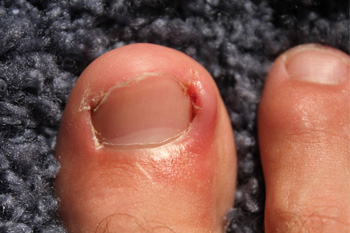 A condition that is referred to as ingrown toenails commonly develops as a result of the toenails being trimmed incorrectly. This occurs when the corners of the nail grow into the skin, often producing pain and discomfort. There are several symptoms that may lead to the conclusion that an ingrown toenail has begun to form including redness and swelling around the affected area or a liquid discharge that comes from the nail. If the shoes that are worn fit poorly, this condition may begin to develop in addition to specific repeated activity, in which the toe consistently kicks a ball. The patient may find moderate relief by soaking the toe in warm salt water frequently throughout the day, in addition to inserting a small piece of dry cotton under the affected area. It’s strongly advised to consult with a podiatrist for correct treatment remedies that are right for you.
A condition that is referred to as ingrown toenails commonly develops as a result of the toenails being trimmed incorrectly. This occurs when the corners of the nail grow into the skin, often producing pain and discomfort. There are several symptoms that may lead to the conclusion that an ingrown toenail has begun to form including redness and swelling around the affected area or a liquid discharge that comes from the nail. If the shoes that are worn fit poorly, this condition may begin to develop in addition to specific repeated activity, in which the toe consistently kicks a ball. The patient may find moderate relief by soaking the toe in warm salt water frequently throughout the day, in addition to inserting a small piece of dry cotton under the affected area. It’s strongly advised to consult with a podiatrist for correct treatment remedies that are right for you.
Ingrown toenails may initially present themselves as a minor discomfort, but they may progress into an infection in the skin without proper treatment. For more information about ingrown toenails, contact Dr. Dean D. Hinners of Illinois. Our doctor can provide the care you need to keep you pain-free and on your feet.
Ingrown Toenails
Ingrown toenails are caused when the corner or side of a toenail grows into the soft flesh surrounding it. They often result in redness, swelling, pain, and in some cases, infection. This condition typically affects the big toe and may recur if it is not treated properly.
Causes
- Improper toenail trimming
- Genetics
- Improper shoe fitting
- Injury from pedicures or nail picking
- Abnormal gait
- Poor hygiene
You are more likely to develop an ingrown toenail if you are obese, have diabetes, arthritis, or have any fungal infection in your nails. Additionally, people who have foot or toe deformities are at a higher risk of developing an ingrown toenail.
Symptoms
Some symptoms of ingrown toenails are redness, swelling, and pain. In rare cases, there may be a yellowish drainage coming from the nail.
Treatment
Ignoring an ingrown toenail can have serious complications. Infections of the nail border can progress to a deeper soft-tissue infection, which can then turn into a bone infection. You should always speak with your podiatrist if you suspect you have an ingrown toenail, especially if you have diabetes or poor circulation.
If you have any questions, please feel free to contact one of our offices located in Metropolis and Eldorado, IL . We offer the newest diagnostic and treatment technologies for all your foot care needs.
How to Prevent Toenail Fungus
A fungal infection of the toenails can be unpleasant, embarrassing, and sometimes even painful. In certain people, such as those with diabetes or a compromised immune system, fungal infections can lead to more serious complications. Treating fungal nails can be a daunting task, but there are fortunately many things that you can do to prevent fungal nail infections from developing in the first place. The fungus that causes fungal nail infections thrives in warm, moist environments. To stop your feet from becoming the perfect host for this fungus, opt for breathable footwear and moisture-wicking socks, dry your feet and the spaces between your toes thoroughly after washing, and wear shoes in wet public spaces like locker rooms and swimming pools. Keep your toenails clean and short, and avoid sharing your nail clippers and other personal items, such as towels, with others. For more information about fungal nail infections, consult with a podiatrist today.
For more information about treatment, contact Dr. Dean D. Hinners of Illinois. Our doctor can provide the care you need to keep you pain-free and on your feet.
Toenail Fungus Treatment
Toenail fungus is a condition that affects many people and can be especially hard to get rid of. Fortunately, there are several methods to go about treating and avoiding it.
Antifungals & Deterrence
Oral antifungal medicine has been shown to be effective in many cases. It is important to consult with a podiatrist to determine the proper regiment for you, or potentially explore other options.
Applying foot powder on the feet and shoes helps keep the feet free of moisture and sweat.
Sandals or open toed shoes – Wearing these will allow air movement and help keep feet dry. They also expose your feet to light, which fungus cannot tolerate. Socks with moisture wicking material also help as well.
If you have any questions please feel free to contact one of our offices located in Metropolis and Eldorado, IL . We offer the newest diagnostic tools and technology to treat your foot and ankle needs.
The Role of Podiatrists
The type of doctor that provides foot care is referred to as a podiatrist. They are responsible for diagnosing medical concerns of the feet and ankles, and many of these types of doctors are qualified to perform surgery. There are specific skills that are needed to become successful in this field. These can consist of possessing critical thinking abilities, understanding the details pertaining to the patient's injury or chronic foot pain, in addition to communicating effectively. Mandatory education consists of obtaining a Doctor of Podiatric Medicine (DPM) degree, and this generally takes four years to complete. This is preceded by three years of required education in specific sciences and general courses. It is suggested to consult with a podiatrist if you are interested in pursuing a career in podiatry.
If you are experiencing pain in the feet or ankles, don’t join the stubborn majority refusing treatment. Feel free to contact Dr. Dean D. Hinners from Illinois. Our doctor can provide the care you need to keep you pain-free and on your feet.
What Is a Podiatrist?
Someone would seek the care of a podiatrist if they have suffered a foot injury or have common foot ailments such as heal spurs, bunions, arch problems, deformities, ingrown toenails, corns, foot and ankle problems, etc.
Podiatric Treatment
A podiatrist will treat the problematic areas of the feet, ankle or lower leg by prescribing the following:
- Physical therapy
- Drugs
- Orthotic inserts or soles
- Surgery on lower extremity fractures
A common podiatric procedure a podiatrist will use is a scanner or force plate which will allow the podiatrist to know the designs of orthotics. Patients are then told to follow a series of tasks to complete the treatment. The computer will scan the foot a see which areas show weight distribution and pressure points. The podiatrist will read the analysis and then determine which treatment plans are available.
If you have any questions please feel free to contact one of our offices located in Metropolis and Eldorado, IL . We offer the newest diagnostic and treatment technologies for all your foot and ankle needs.
More...
Gout Affects Men More Often Than Women
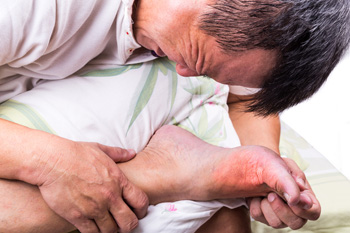 Patients who suffer from gout attacks are most likely familiar with the intense pain and discomfort this condition can cause. It is known as an inflammatory arthritis, and research has indicated that men are affected by this ailment more than women. It may develop as a result of lifestyle choices that can include a lack of exercise and eating foods that have elevated purine levels. This can cause crystals to form in the joints of the big toe, and many patients equate it with stabbing-like sensations. These types of foods can consist of shellfish, red meat, and drinks that have a high sugar content. Additional reasons why this condition may occur can include genetic factors, taking specific medications, or being overweight. If you have developed gout and have frequent attacks, it is suggested that you consult with a podiatrist who can guide you toward proper treatment, in addition to helping you to implement preventative methods.
Patients who suffer from gout attacks are most likely familiar with the intense pain and discomfort this condition can cause. It is known as an inflammatory arthritis, and research has indicated that men are affected by this ailment more than women. It may develop as a result of lifestyle choices that can include a lack of exercise and eating foods that have elevated purine levels. This can cause crystals to form in the joints of the big toe, and many patients equate it with stabbing-like sensations. These types of foods can consist of shellfish, red meat, and drinks that have a high sugar content. Additional reasons why this condition may occur can include genetic factors, taking specific medications, or being overweight. If you have developed gout and have frequent attacks, it is suggested that you consult with a podiatrist who can guide you toward proper treatment, in addition to helping you to implement preventative methods.
Gout is a painful condition that can be treated. If you are seeking treatment, contact Dr. Dean D. Hinners from Illinois. Our doctor will treat your foot and ankle needs.
What Is Gout?
Gout is a form of arthritis that is characterized by sudden, severe attacks of pain, redness, and tenderness in the joints. The condition usually affects the joint at the base of the big toe. A gout attack can occur at any random time, such as the middle of the night while you are asleep.
Symptoms
- Intense Joint Pain - Usually around the large joint of your big toe, and it most severe within the first four to twelve hours
- Lingering Discomfort - Joint discomfort may last from a few days to a few weeks
- Inflammation and Redness -Affected joints may become swollen, tender, warm and red
- Limited Range of Motion - May experience a decrease in joint mobility
Risk Factors
- Genetics - If family members have gout, you’re more likely to have it
- Medications - Diuretic medications can raise uric acid levels
- Gender/Age - Gout is more common in men until the age of 60. It is believed that estrogen protects women until that point
- Diet - Eating red meat and shellfish increases your risk
- Alcohol - Having more than two alcoholic drinks per day increases your risk
- Obesity - Obese people are at a higher risk for gout
Prior to visiting your podiatrist to receive treatment for gout, there are a few things you should do beforehand. If you have gout you should write down your symptoms--including when they started and how often you experience them, important medical information you may have, and any questions you may have. Writing down these three things will help your podiatrist in assessing your specific situation so that he or she may provide the best route of treatment for you.
If you have any questions, please feel free to contact one of our offices located in Metropolis and Eldorado, IL . We offer the newest diagnostic and treatment technologies for all your foot care needs.
What Causes Gout?
 Gout is a condition characterized by acute pain and inflammation in the joints that is caused by a buildup of uric acid. The joints of the feet, and especially the joint at the base of the big toe, are frequently affected. Symptoms of gout include sudden severe pain in one or more joints, skin discoloration, warmth, and swelling over the affected area, chills, fever, and a general feeling of illness. The buildup of uric acid that causes gout symptoms to develop may be due to the body producing too much uric acid. Another factor may be the kidneys not being able to get rid of enough uric acid, or from eating foods high in purines, which get converted to uric acid in the body. Gout attacks can be triggered by drinking alcohol, eating a lot of protein-rich foods, emotional stress, fatigue, illness, and minor surgery. For more information about gout, consult with a podiatrist today.
Gout is a condition characterized by acute pain and inflammation in the joints that is caused by a buildup of uric acid. The joints of the feet, and especially the joint at the base of the big toe, are frequently affected. Symptoms of gout include sudden severe pain in one or more joints, skin discoloration, warmth, and swelling over the affected area, chills, fever, and a general feeling of illness. The buildup of uric acid that causes gout symptoms to develop may be due to the body producing too much uric acid. Another factor may be the kidneys not being able to get rid of enough uric acid, or from eating foods high in purines, which get converted to uric acid in the body. Gout attacks can be triggered by drinking alcohol, eating a lot of protein-rich foods, emotional stress, fatigue, illness, and minor surgery. For more information about gout, consult with a podiatrist today.
Gout is a foot condition that requires certain treatment and care. If you are seeking treatment, contact Dr. Dean D. Hinners from Illinois. Our doctor will treat your foot and ankle needs.
What Is Gout?
Gout is a type of arthritis caused by a buildup of uric acid in the bloodstream. It often develops in the foot, especially the big toe area, although it can manifest in other parts of the body as well. Gout can make walking and standing very painful and is especially common in diabetics and the obese.
People typically get gout because of a poor diet. Genetic predisposition is also a factor. The children of parents who have had gout frequently have a chance of developing it themselves.
Gout can easily be identified by redness and inflammation of the big toe and the surrounding areas of the foot. Other symptoms include extreme fatigue, joint pain, and running high fevers. Sometimes corticosteroid drugs can be prescribed to treat gout, but the best way to combat this disease is to get more exercise and eat a better diet.
If you have any questions please feel free to contact one of our offices located in Metropolis and Eldorado, IL . We offer the newest diagnostic and treatment technologies for all your foot and ankle needs.
What Are Plantar Warts?
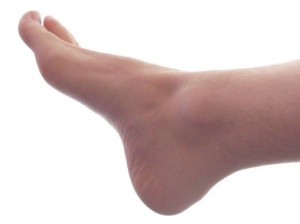 There are over 100 different varieties of HPV, or human papilloma virus. Nearly 12% of the global population have had warts at one time, and plantar warts are but one of these types. They all share one basic characteristic, they have the ability to infect skin cells. Many people, when they hear the term HPV, think that it refers to genital warts. But this is not the case, and HPV can manifest itself in many different forms. Plantar warts occur on the feet, typically on the palms or the soles. They can be flat or raised, and usually occur in dry, cracked areas of the foot. Treatments vary in scope and effectiveness. If you think you may have a plantar wart, talk to your podiatrist and go through the treatment options available.
There are over 100 different varieties of HPV, or human papilloma virus. Nearly 12% of the global population have had warts at one time, and plantar warts are but one of these types. They all share one basic characteristic, they have the ability to infect skin cells. Many people, when they hear the term HPV, think that it refers to genital warts. But this is not the case, and HPV can manifest itself in many different forms. Plantar warts occur on the feet, typically on the palms or the soles. They can be flat or raised, and usually occur in dry, cracked areas of the foot. Treatments vary in scope and effectiveness. If you think you may have a plantar wart, talk to your podiatrist and go through the treatment options available.
Plantar warts can be very uncomfortable. If you need your feet checked, contact Dr. Dean D. Hinners from Illinois. Our doctor will assist you with all of your foot and ankle needs.
About Plantar Warts
Plantar warts are the result of HPV, or human papillomavirus, getting into open wounds on the feet. They are mostly found on the heels or balls of the feet.
While plantar warts are generally harmless, those experiencing excessive pain or those suffering from diabetes or a compromised immune system require immediate medical care. Plantar warts are easily diagnosed, usually through scraping off a bit of rough skin or by getting a biopsy.
Symptoms
- Lesions on the bottom of your feet, usually rough and grainy
- Hard or thick callused spots
- Wart seeds, which are small clotted blood vessels that look like little black spots
- Pain, discomfort, or tenderness of your feet when walking or standing
Treatment
- Freezing
- Electric tool removal
- Laser Treatment
- Topical Creams (prescription only)
- Over-the-counter medications
To help prevent developing plantar warts, avoid walking barefoot over abrasive surfaces that can cause cuts or wounds for HPV to get into. Avoiding direct contact with other warts, as well as not picking or rubbing existing warts, can help prevent the further spread of plantar warts. However, if you think you have developed plantar warts, speak to your podiatrist. He or she can diagnose the warts on your feet and recommend the appropriate treatment options.
If you have any questions please feel free to contact one of our offices located in Metropolis and Eldorado, IL . We offer the newest diagnostic and treatment technologies for all your foot and ankle needs.
Who Does Sever’s Disease Affect?
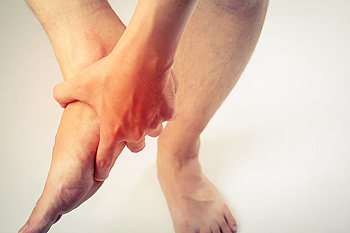 The medical condition that is referred to as Sever’s disease affects the growth plate in the heel. It typically occurs during a growth spurt that happens during puberty. The people that may experience this are teenagers who participate in running and jumping activities, and the growth plate may become injured. The symptoms that are commonly associated with this condition include heel pain, limping, and the feet may feel stiff upon arising in the morning. Mild relief can be found when shoe inserts are worn which can help to protect the heel, and wearing an elastic bandage may aid in reducing existing pain and swelling. If you notice your child is experiencing any of these symptoms, please schedule a consultation with a podiatrist, who can properly diagnosis and treat Sever’s disease.
The medical condition that is referred to as Sever’s disease affects the growth plate in the heel. It typically occurs during a growth spurt that happens during puberty. The people that may experience this are teenagers who participate in running and jumping activities, and the growth plate may become injured. The symptoms that are commonly associated with this condition include heel pain, limping, and the feet may feel stiff upon arising in the morning. Mild relief can be found when shoe inserts are worn which can help to protect the heel, and wearing an elastic bandage may aid in reducing existing pain and swelling. If you notice your child is experiencing any of these symptoms, please schedule a consultation with a podiatrist, who can properly diagnosis and treat Sever’s disease.
Sever's disease often occurs in children and teens. If your child is experiencing foot or ankle pain, see Dr. Dean D. Hinners from Illinois. Our doctor can treat your child’s foot and ankle needs.
Sever’s Disease
Sever’s disease is also known as calcaneal apophysitis, which is a medical condition that causes heel pain I none or both feet. The disease is known to affect children between the ages of 8 and 14.
Sever’s disease occurs when part of the child’s heel known as the growth plate (calcaneal epiphysis) is attached to the Achilles tendon. This area can suffer injury when the muscles and tendons of the growing foot do not keep pace with bone growth. Therefore, the constant pain which one experiences at the back of the heel will make the child unable to put any weight on the heel. The child is then forced to walk on their toes.
Symptoms
Acute pain – Pain associated with Sever’s disease is usually felt in the heel when the child engages in physical activity such as walking, jumping and or running.
Highly active – Children who are very active are among the most susceptible in experiencing Sever’s disease, because of the stress and tension placed on their feet.
If you have any questions, please feel free to contact one of our offices located in Metropolis and Eldorado, IL . We offer the newest diagnostic and treatment technologies for all your foot and ankle injuries.

